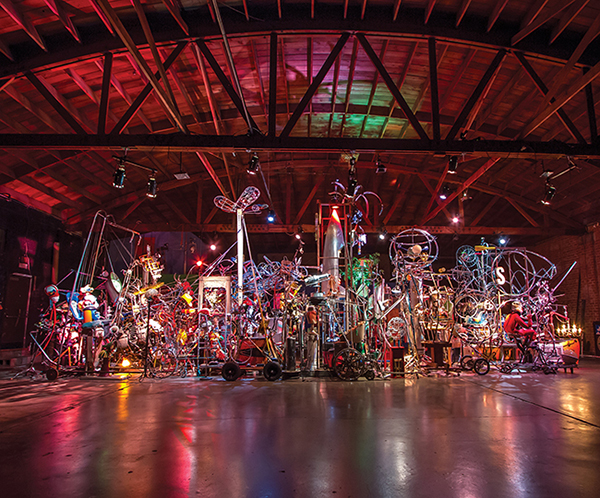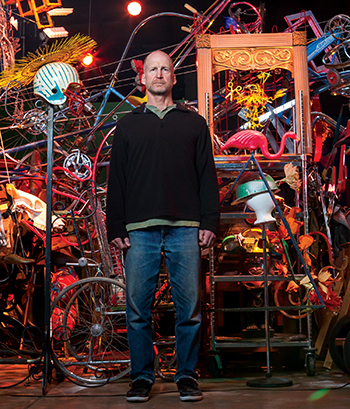The Ark & The Links – Ned Schaper’s Move
Stepping into the Mat Bevel Institute is entering an orbit where whimsy and physics converge and any trace of what society says should or shouldn’t be doesn’t enter, or stay for long. There’s a magical energy that defies conformity, comprised of characters built from lost-then-found objects – spinning and dancing and gyrating, showing mirth, or silly hilarity or exuberant joy. There’s a story behind them all, and a majority of the stories are deeply and philosophically profound.
The numerous personalities comprising this large body of work residing at the Institute have shipping orders, however, that were given on February 11, 2013. They must move out of their home on Stone Avenue by March 1, 2014. Their creator has them aligned in an ark, “ready to float out. It’s an ark, that’s what arks do, they float,” he states.
For the last 17 years Ned Schaper, the man behind the kinetic art, has been creating (poetry, performances, sculptures) and living in the 5,000 square foot warehouse at 530 N. Stone Ave. Before moving into the Arizona Department of Transportation owned building in 1996, which was the cutting-edge Downtown Performance Center from 1991-1995, Schaper was previously creating in a warehouse that was torn down to accommodate the courthouse complex currently under construction at Stone and Toole Avenues. Old school Tucsonans might remember that building as the Outback at one point, then as Coconuts.
“I was across the street from Steve Eye’s, and I was in there and had to get out of there, real quick–they gave me 15 days–so I went to where Skrappy’s is now. I had to go to that other warehouse so I built the stuff into the shape of an ark in the early nineties. I came up with this whole thing–the beveled ark, Ark D’Bevel, and ever since then I’ve always noticed that my places are sort of ark-like, these buildings.” We look up at the ceiling and the gorgeous, valuable wood is indeed shaped like the bottom of an ark.
Over the years, Ned’s space has served as various venues. “We had a snack bar. We did Zeitgeist Jazz–we had all these great jazz people, I had my shows, we had freak shows, the All Souls Procession used to end here. Oh my God, it would be insane, oh man, this place would be filled, not to mention the big head puppets, masses of people all around the building, masses of people outside, and, it was amazing back then. Then it was a total creators’ community. It was cheap down here and nobody wanted to be here,” Schaper recalls.
It’s true, Downtown was a dive in the 90s. It was cheap and gritty and the creative community thrived.
“Now you find yourself in this community in 2013 and now it’s: ‘How much can you pay for rent?’ And Steve Eye’s over there (at Solar Culture), and he says, ‘You should stay here, we want you here, you should be in the neighborhood.’ And they (property owners) ask how much I can pay for rent, and it’s: ‘Nothing’.” He says it with a shrug.
“I’m completely broke, I make things for nothing. All I’ve had to do is pay the rent. I’ve never had money; I’ve never been a money raiser. When you are in a money thing, it’s not about creation, it’s about rent. Everybody wants money. I have a whole ark of kinetic art, but no money, so I can’t be here. I need to be in a place where I’m not competing with bars and lawyers. I have to have money to be here, but not art.
“It’s not just here, it’s everywhere. It’s part of our society.”
Schaper states all of these points as simple facts, there’s no anger in his voice, no malice in his sky-blue eyes. Maybe it is the pragmatic mid-westerner in him, he grew up in Ohio and graduated from University of Wisconsin Madison, or maybe it’s the ‘live and let live’ peace that comes with not over-thinking things and trusting in que sera sera.
Schaper is “very seriously considering South Tucson, almost for sure. I’ve been to City Hall twice to talk to them, and I’ve never had such enthusiasm, I mean, they have no money and no buildings but, it just seems like I need to go where there’s very fertile soil where I can grow into it. The more I go down to South Tucson… you can say in one way, they’re not as infected by the modern sort of young professional thing, but, the idea there is they are in an economic situation that is much more like mine.”
There’s a down-to-earth element to Schaper’s other-worldliness. He is refreshingly not stomping his feet, he likens the situation to insect behavior. Which makes sense as his bachelor’s degree from UW Madison is in entomology.
He explains how swarm behavior works, when hives break, how they come back together and compares it to other human cultures. “What I’ve read about real community consensus is that they won’t make a decision until everyone agrees with it. But if you’ve got people in there who are ideologues and who won’t give up, you’ll never get a consensus and what you finally have to do is say, ‘Well, it looks like this is the way it’s going. Okay.’”
Schaper has known for almost a year that he would need to move, and is in no way disputing that. For him, the main issue now is finding a temporary–or permanent–dock to anchor The Ark before his Tucson Museum of Art show, “Welcome to Beveldom – Mat Bevel’s Museum Of Kinetic Art,” on exhibit Aug. 9-Oct. 5.
“I have a one-man show at the Tucson Museum of Art, so, that’s a big part of this,” he says, nodding at his sculptures. “A lot of this is going in the show, not all of it.
“My main priority now is to find a place to set The Ark up between March 1 and the TMA show in August.”
Ned is hoping for a visible space with large windows that someone would let him set up his fantastical creations in as a pre-show attraction.
Schaper, like many other artists who took advantage of cheap rents in the Arizona Department of Transportation-owned warehouses in the 80s and 90s, are betwixt a mix of decades of Downtown revitalization efforts and the Downtown Links’ transportation plans that are slowly, and steadily, coming to fruition to unite Barraza-Aviation Parkway to I-10.
There are no angels or demons here, but there are lively groups of constituents who have been active over the years to bring to the table the current, mostly solidified plan.
“We are almost at 90% design completion and have held regular CAC (citizens’ advisory committee) meetings and subcommittee meetings for the last few years and another two years to go before construction begins,” explains Tom Fisher, Downtown Links Planning Project Manager via email. “The project is fully funded and we are moving forward with the remaining property acquisitions following Federal guidelines. The issues (concerning historic preservation efforts, demolitions, underpass and overpass designs, bike and pedestrian connectivity) should be fully resolved in the next several months through ongoing design work with our CAC review.”
What most people do not realize is the intense amount of governmental planning and environmental considerations being addressed in this $85.67 million transportation project. After acquiring properties through years of consulting with constituents, city departments, Mayor and Council and the Regional Transportation Authority (who is paying $76.1 million of the tab), the next steps include extensive environmental evaluations. Let’s not forget, this land along Sixth Street abuts an over-century-old stretch of railroad activity.
Fisher further explains that “Once the properties are vacated, we will do an environmental assessment of each and remove any hazardous materials (i.e. asbestos, fuel tanks, soil contamination) and prepare a scope of work for demolition. Then we go out to bid for the demo work and site clean-up. All this can take months to complete. One of our goals is to preserve the Steinfeld and Citizen warehouses, and will continue to do so to make them successful during redevelopment efforts.”
The scope of the project is ultimately about moving people to and fro – in cars, on bikes, on feet. Fisher elucidates that the current design offers “a four-lane surface arterial roadway with street intersections, bike lanes, sidewalks, a shared-use path, deck park, native desert landscaping, lighting, and many other features more compatible with the urban environment. It is important to note that this was a directive from Mayor and Council to make the roadway more compatible with the existing urban environment and not simply a cross-town freeway bypass.”
There’s always an ebb and flow to urban areas. So many cities have seen districts evolve from vibrant to crummy, to artists, to hipster to developer. It’s the way of things. Having that understanding and acceptance is vital.
“I’ve learned a lot and that’s what’s sort of nice about feeling like a homeless person in a garage, it’s humbled me,” Schaper says. “And there’s nothing like humility to teach you how to create. Because, your job is not to save the world, your job is to do what you are supposed to do to – and if everybody sort of does that… react to the best of your ability of what comes at you, the world will work out.
“In other words, if you don’t have what you need, why would you be doing it?”
The Mat Bevel Institute’s website is MatBevel.com, where information on Schaper’s upcoming move and ways to donate to the process will be available. Contact him at bevel@matbevel.com or (520) 304-8899. His neighbor to the south, architect/builder Paul Schwam of Solar Lava, SolarLava.com, will be a part of the Downtown Links relocation process. The Downtown Links project is working on updating its website as well, and should be live sometime mid- to late-January, at DowntownLinks.info.
Category: Arts, Community, DOWNTOWN / UNIVERSITY / 4TH AVE






